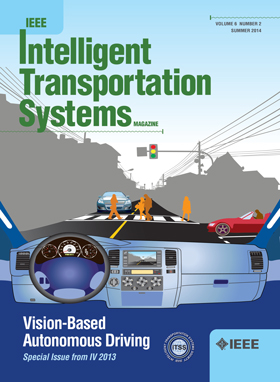Lane Detection on Rainy Nights Based on Memory and Discretization Mechanisms
IF 8.4
1区 工程技术
Q1 ENGINEERING, CIVIL
IEEE Transactions on Intelligent Transportation Systems
Pub Date : 2025-06-10
DOI:10.1109/TITS.2025.3574763
引用次数: 0
Abstract
The reflections of multi-colored lights involved on rainy nights present strong uncertainties and abruptness, resulting in a high rate of false and missed detections in existing methods. To solve this issue, this paper proposes a lane detection method based on memory and discretization mechanisms. Firstly, a Memory Fruit-fly-optimizer with Individual Differences (MFID) is innovatively proposed to drive Multi-threshold Otsu (MOtsu)-based multi-class segmentation of lanes, which is a high-dimensional optimization task with real-time and local optimal challenges, for capturing lane clues obscured in multi-intensity reflections, consequently reducing missed detections. Specifically, to solve the challenges inherent in the task, the MFID incorporates a novel memory mechanism to establish fast-converging initial conditions for real-time detection, while creatively considering individual differences to motivate multi-swarm optimization that mitigates local optima risks. After integration, the MFID-MOtsu is constructed for lane segmentation. Subsequently, a dynamic discretization mechanism is proposed to efficiently separate lane edges from interference edges, mitigating accuracy degradation caused by their entanglement. Finally, the false detection issue is greatly reduced through the implementation of adaptive geometric filters. The experimental results demonstrate that the proposed method achieves an average accuracy of 93.21% on rainy nights, indicating an average improvement of 12.7% over state-of-the-art methods. Additionally, without any parameter modifications, the proposed method is applicable to both normal and classic challenging scenes, such as nights, tunnels, rainy days, and shadows. The algorithm achieves an average accuracy of 96.2% and an average detection speed of 46 frames per second.基于记忆和离散化机制的雨夜车道检测
雨夜多色光的反射具有很强的不确定性和突然性,导致现有方法的误检率和漏检率很高。为了解决这一问题,本文提出了一种基于记忆和离散化机制的车道检测方法。首先,创新性地提出了一种基于个体差异的记忆果蝇优化器(MFID)来驱动基于多阈值大津(MOtsu)的多类别车道分割,这是一项具有实时和局部最优挑战的高维优化任务,用于捕获多强度反射中模糊的车道线索,从而减少漏检。具体来说,为了解决任务中固有的挑战,MFID结合了一种新的记忆机制来建立快速收敛的实时检测初始条件,同时创造性地考虑个体差异来激发多群优化,从而降低局部最优风险。整合后,构造MFID-MOtsu进行车道分割。在此基础上,提出了一种动态离散化机制,有效地将车道边缘与干扰边缘分离,降低了车道边缘纠缠对精度的影响。最后,通过自适应几何滤波器的实现,大大降低了误检问题。实验结果表明,该方法在雨夜的平均准确率为93.21%,比现有方法平均提高12.7%。此外,在不修改参数的情况下,该方法既适用于正常场景,也适用于经典的挑战性场景,如夜晚、隧道、雨天和阴影。该算法的平均检测准确率为96.2%,平均检测速度为46帧/秒。
本文章由计算机程序翻译,如有差异,请以英文原文为准。
求助全文
约1分钟内获得全文
求助全文
来源期刊

IEEE Transactions on Intelligent Transportation Systems
工程技术-工程:电子与电气
CiteScore
14.80
自引率
12.90%
发文量
1872
审稿时长
7.5 months
期刊介绍:
The theoretical, experimental and operational aspects of electrical and electronics engineering and information technologies as applied to Intelligent Transportation Systems (ITS). Intelligent Transportation Systems are defined as those systems utilizing synergistic technologies and systems engineering concepts to develop and improve transportation systems of all kinds. The scope of this interdisciplinary activity includes the promotion, consolidation and coordination of ITS technical activities among IEEE entities, and providing a focus for cooperative activities, both internally and externally.
 求助内容:
求助内容: 应助结果提醒方式:
应助结果提醒方式:


